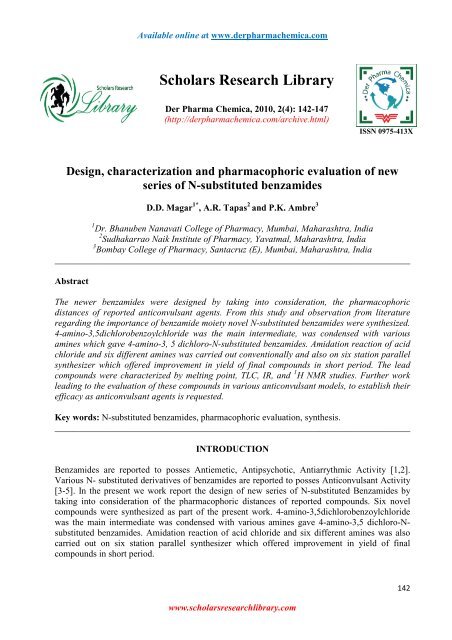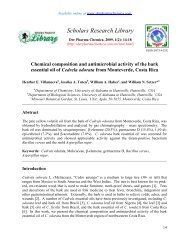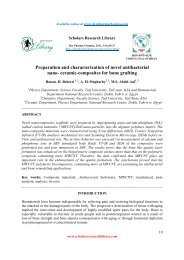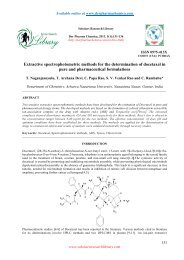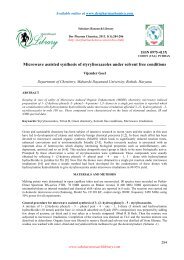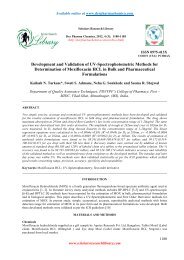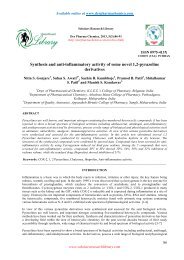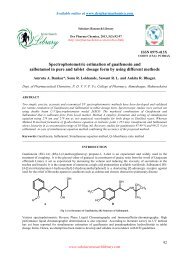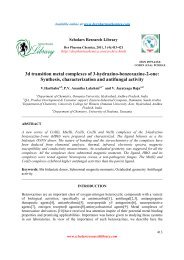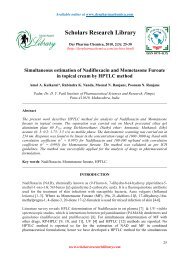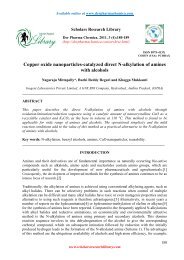Read the Complete article - Der Pharma Chemica
Read the Complete article - Der Pharma Chemica
Read the Complete article - Der Pharma Chemica
Create successful ePaper yourself
Turn your PDF publications into a flip-book with our unique Google optimized e-Paper software.
Available online at www.derpharmachemica.com<br />
Scholars Research Library<br />
<strong>Der</strong> <strong>Pharma</strong> <strong>Chemica</strong>, 2010, 2(4): 142-147<br />
(http://derpharmachemica.com/archive.html)<br />
ISSN 0975-413X<br />
Design, characterization and pharmacophoric evaluation of new<br />
series of N-substituted benzamides<br />
D.D. Magar 1* , A.R. Tapas 2 and P.K. Ambre 3<br />
1 Dr. Bhanuben Nanavati College of <strong>Pharma</strong>cy, Mumbai, Maharashtra, India<br />
2 Sudhakarrao Naik Institute of <strong>Pharma</strong>cy, Yavatmal, Maharashtra, India<br />
3 Bombay College of <strong>Pharma</strong>cy, Santacruz (E), Mumbai, Maharashtra, India<br />
______________________________________________________________________________<br />
Abstract<br />
The newer benzamides were designed by taking into consideration, <strong>the</strong> pharmacophoric<br />
distances of reported anticonvulsant agents. From this study and observation from literature<br />
regarding <strong>the</strong> importance of benzamide moiety novel N-substituted benzamides were syn<strong>the</strong>sized.<br />
4-amino-3,5dichlorobenzoylchloride was <strong>the</strong> main intermediate, was condensed with various<br />
amines which gave 4-amino-3, 5 dichloro-N-substituted benzamides. Amidation reaction of acid<br />
chloride and six different amines was carried out conventionally and also on six station parallel<br />
syn<strong>the</strong>sizer which offered improvement in yield of final compounds in short period. The lead<br />
compounds were characterized by melting point, TLC, IR, and 1 H NMR studies. Fur<strong>the</strong>r work<br />
leading to <strong>the</strong> evaluation of <strong>the</strong>se compounds in various anticonvulsant models, to establish <strong>the</strong>ir<br />
efficacy as anticonvulsant agents is requested.<br />
Key words: N-substituted benzamides, pharmacophoric evaluation, syn<strong>the</strong>sis.<br />
______________________________________________________________________________<br />
INTRODUCTION<br />
Benzamides are reported to posses Antiemetic, Antipsychotic, Antiarrythmic Activity [1,2].<br />
Various N- substituted derivatives of benzamides are reported to posses Anticonvulsant Activity<br />
[3-5]. In <strong>the</strong> present we work report <strong>the</strong> design of new series of N-substituted Benzamides by<br />
taking into consideration of <strong>the</strong> pharmacophoric distances of reported compounds. Six novel<br />
compounds were syn<strong>the</strong>sized as part of <strong>the</strong> present work. 4-amino-3,5dichlorobenzoylchloride<br />
was <strong>the</strong> main intermediate was condensed with various amines gave 4-amino-3,5 dichloro-Nsubstituted<br />
benzamides. Amidation reaction of acid chloride and six different amines was also<br />
carried out on six station parallel syn<strong>the</strong>sizer which offered improvement in yield of final<br />
compounds in short period.<br />
www.scholarsresearchlibrary.com<br />
142
D.D. Magar et al <strong>Der</strong> <strong>Pharma</strong> <strong>Chemica</strong>, 2010, 2 (4):142-147<br />
______________________________________________________________________________<br />
RESULTS AND DISCUSSION<br />
The two-point pharmacophore of reported compounds was generated using Molecular Operating<br />
Environment (MOE) software version 2005.06. The essential requirement for anticonvulsant<br />
activity was found to be presence of at least one aromatic ring and hydrogen bond<br />
donor/acceptor unit. The distances of hydrogen bond donor/acceptor to aromatic region for<br />
reported compounds were in <strong>the</strong> range of 3.46-6.84 A while <strong>the</strong> designed series was 3.47- 4.62<br />
A 0 . Designed series of N-substituted benzamides were syn<strong>the</strong>sized by oxidative chlorination of<br />
p- amino benzoic acid (1) which gave 4-amino-3,5-dichorobenzoic acid (2). The acid halide (3)<br />
was obtained using phosphorus pentachloride, which was fur<strong>the</strong>r condensed with various<br />
substituted amines yielded <strong>the</strong> desired series of N-substituted benzamides (4a-f). Amidation<br />
reaction of acid chloride and six different amines was also carried out on six station parallel<br />
syn<strong>the</strong>sizer MINIBLOCK TM XT. In <strong>the</strong> conventional syn<strong>the</strong>sis, average yield of final substituted<br />
benzamides was 55-60% while in parallel syn<strong>the</strong>sizer 75-80%. The time taken for completion<br />
was 10 min. Parallel syn<strong>the</strong>sizer offered advantage of precise temperature control, efficient<br />
magnetic stirring, and easy reaction set up, and more syn<strong>the</strong>sized compounds per unit time with<br />
improved yields of final product. Yields of last step were optimized by varying temperature<br />
condition and stirring. The homogenity of <strong>the</strong> compounds was monitored by thin layer<br />
chromatography (TLC) on silica-G (Merck) coated glass plates, visualized by iodine vapour. The<br />
compounds were characterized by 1 H nuclear magnetic resonance, FT-infrared spectroscopy in<br />
which it complies with normal values.<br />
In <strong>the</strong> present work six derivatives of 4-amino-3,5 dichloro-N-substituted benzamides were<br />
syn<strong>the</strong>sized by convential and parallel syn<strong>the</strong>sizer. Fig 1.<br />
Fig 1: Scheme for Syn<strong>the</strong>sis: Syn<strong>the</strong>tic protocol of N-substituted benzamides<br />
www.scholarsresearchlibrary.com<br />
143
D.D. Magar et al <strong>Der</strong> <strong>Pharma</strong> <strong>Chemica</strong>, 2010, 2 (4):142-147<br />
______________________________________________________________________________<br />
Experimental<br />
<strong>Pharma</strong>cophore development<br />
<strong>Pharma</strong>cophore study was carried out by Molecular Operating Environment (MOE; version<br />
2005.06, Canada) working on Pentium IV Windows workstation. A two-point pharmacophore<br />
was designed using a training set of antiepileptic drugs such as phenytoin, carbamazepine,<br />
lamotrigine, rufinamide and remacemide. The important structural features essential for<br />
anticonvulsant activity were identified. This pharmacophore was used to design <strong>the</strong> newer<br />
molecules by restricting <strong>the</strong> distance (3.46-6.84 A 0 ) from Hydrogen bond acceptor or donor to<br />
aromatic center. The test compounds showed a good map on designed pharmacophore (r 2 =<br />
0.942). There were presence of at least one phenyl ring and H-bond acceptor / donor group<br />
(H.A/D). (Fig 2).<br />
H.A. /D ------------------------------------> ARO.<br />
3.46-6.84 A 0<br />
<strong>Pharma</strong>cophore for reported compounds<br />
H.A. /D ------------------------------------> ARO.<br />
3.47-4.62 A 0<br />
<strong>Pharma</strong>cophore for test compounds<br />
H.A./D ���� Hydrogen Acceptor/ Donor<br />
ARO. ���� Aromatic Nucleus<br />
Fig 2: <strong>Pharma</strong>cophore studies of compounds<br />
Syn<strong>the</strong>sis of designed series<br />
Melting points were determined in open capillary tubes on a Thermonik melting point apparatus<br />
and are uncorrected. Wherever required solvents were removed in vacuo on ‘BUCHI’<br />
rotaevaporator. Infrared (IR) spectra were recorded for <strong>the</strong> compounds on Jasco FT/IR 5300<br />
(KBr). The 1 H-NMR (300.0 MHz) spectra were recorded on Varian VX-300 (Fourier Transform)<br />
instrument. In proton nuclear magnetic resonance spectroscopy all exchangeable protons were<br />
confirmed by addition of D2O. <strong>Chemica</strong>l shifts are reported in ppm (δ) using tetra-methyl silane<br />
(TMS) as internal standard. All solvents & reagents used were of laboratory grade. All <strong>the</strong><br />
solvents were distilled prior to use. 4-amino-3,5-dichlorobenzoic acid (2) was syn<strong>the</strong>sized from<br />
p-amino benzoic acid (1) according to <strong>the</strong> earlier reported methods [6].<br />
4-amino-3,5-dichlorobenzoic acid: Yield: 62.22% m.p. 290 0 C (lit. 291 0 C)<br />
4-amino-3,5 dichlorobenzoyl chloride (3) was syn<strong>the</strong>sized from 4-amino-3,5 dichlorobenzoic<br />
acid (2) according to <strong>the</strong> earlier reported methods [7].<br />
The crude Compound (3) was taken up for fur<strong>the</strong>r syn<strong>the</strong>sis.<br />
Condensation of amines with 4-amino-3,5 dichlorobenzoylchloride[8]:<br />
(4a-4f)<br />
Compound (3) was dissolved in dimethylacetamide (DMA) condensed with six different amines<br />
for preparation of substituted benzamides.<br />
Syn<strong>the</strong>sis of 4-amino-3,5-dichloro-N-phenyl benzamide (4a)<br />
In a 50 ml RBF fitted with anhydrous calcium chloride guard tube <strong>the</strong> mixture of 0.37g (0.004<br />
M) aniline in 0.44g (0.004 M) triethylamine and 1.44g DMA was stirred at 0ºC. To this mixture,<br />
1g (0.004 M) of Compound (3) in 2.2 ml of DMA was added dropwise. Reaction was continued<br />
for 30 mins., cold water was added to <strong>the</strong> reaction mixture and fur<strong>the</strong>r stirred for 30 min.<br />
Separated solid was filtered and recrystalized from methanol:water mixture. M.P.: 160 ºC, Yield:<br />
0.8g (61.53 %).<br />
www.scholarsresearchlibrary.com<br />
144
D.D. Magar et al <strong>Der</strong> <strong>Pharma</strong> <strong>Chemica</strong>, 2010, 2 (4):142-147<br />
______________________________________________________________________________<br />
Syn<strong>the</strong>sis of 4-amino-3,5-dichloro-N-benzyl benzamide (4b)<br />
In a 50 ml RBF fitted with anhydrous calcium chloride guard tube <strong>the</strong> mixture of 0.42g (0.004<br />
M) benzyl amine in 0.44g (0.004 M) triethylamine and 1.44g DMA was stirred at 0ºC. To this<br />
mixture, 1g (0.004 M) of Compound (3) in 2.2 ml of DMA was added dropwise. Reaction was<br />
continued for 30 mins, cold water was added to <strong>the</strong> reaction mixture and fur<strong>the</strong>r stirred for 30<br />
min. Separated solid was filtered and recrystalized from methanol-water mixture. M.P.: 120 ºC,<br />
Yield: 0.9g (67.85 %).<br />
Syn<strong>the</strong>sis of 4-amino-3,5-dichloro-N-phenylethyl benzamide (4c)<br />
In a 50 ml RBF fitted with anhydrous calcium chloride guard tube <strong>the</strong> mixture of 0.53g (0.004<br />
M) phenylethylamine in 0.44g (0.004 M) triethylamine and 1.44g DMA was stirred at. 0ºC. To<br />
this mixture, 1g (0.004 M) of Compound (3) in 2.2 ml of DMA was added dropwise. Reaction<br />
was continued for 30 mins, cold water was added to <strong>the</strong> reaction mixture and fur<strong>the</strong>r stirred for<br />
30 min Separated solid was filtered and recrystalized from methanol-water mixture. M.P.: 200<br />
ºC, Yield: 0.9g (64.66 %).<br />
Syn<strong>the</strong>sis of 4-amino-3,5-dichloro-N-(4-methylpiperizine) benzamide (4d)<br />
In a 50 ml RBF fitted with anhydrous calcium chloride guard tube <strong>the</strong> mixture of 0.44g (0.004<br />
M) N-methyl piperazine in 0.44g (0.004 M) triethylamine and 1.44g DMA was stirred at 0ºC. To<br />
this mixture, 1g (0.004 M) of Compound (3) in 2.2 ml of DMA was added dropwise. Reaction<br />
was continued for 30 mins, cold water was added to <strong>the</strong> reaction mixture and fur<strong>the</strong>r stirred for<br />
30 min. Separated solid was filtered and recrystalized from methanol-water mixture. M.P.: 128<br />
ºC, Yield: 0.7g (53.84 %).<br />
Syn<strong>the</strong>sis of 4-amino-3,5-dichloro-N-(4-methylpiperidine) benzamide (4e)<br />
In a 50 ml RBF fitted with anhydrous calcium chloride guard tube <strong>the</strong> mixture of 0.39g (0.004<br />
M) 4-methyl piperidine in 0.44 g (0.004 M) triethylamine and 1.44 g DMA was stirred at 0ºC. To<br />
this mixture, 1g (0.004 M) of Compound (3) in 2.2 ml of DMA was added dropwise. Reaction<br />
was continued for 30 mins, cold water was added to <strong>the</strong> reaction mixture and fur<strong>the</strong>r stirred for<br />
30 min.Reaction mixture was extracted using ethyl acetate and solvent was removed on rotary<br />
evaporator. B.P.: 55 ºC, Yield: 0.72g (51.79 %).<br />
Syn<strong>the</strong>sis of 4-amino-3,5-dichloro-N-(2,3 dichloro phenyl) benzamide (4f)<br />
In a 50 ml RBF fitted with anhydrous calcium chloride guard tube <strong>the</strong> mixture of 0.6g (0.004 M)<br />
benzyl amine in 0.44g (0.004 M) triethylamine and 1.44g DMA was stirred at 0ºC.To this<br />
mixture, 1g (0.004 M) of Compound II in 2.2 ml of DMA was added dropwise. Reaction was<br />
continued for 30 mins, cold water was added to <strong>the</strong> reaction mixture and fur<strong>the</strong>r stirred for 30<br />
min. Separated solid was filtered and recrystalized from methanolwater mixture. M.P.: 220ºC,<br />
Yield: 0.9g (68.75 %).<br />
Amidation reaction of acid chloride and six different amines was also carried out on six station<br />
parallel syn<strong>the</strong>sizer MINIBLOCK TM XT (Fig 3). Yields of last step were optimized by varying<br />
temperature condition and stirring. Comparative values for conventional and parallel syn<strong>the</strong>sizer<br />
are given in Table 1.<br />
www.scholarsresearchlibrary.com<br />
145
D.D. Magar et al <strong>Der</strong> <strong>Pharma</strong> <strong>Chemica</strong>, 2010, 2 (4):142-147<br />
______________________________________________________________________________<br />
Fig 3. MINIBLOCK XT Parallel Syn<strong>the</strong>sizer<br />
Table 1: Yields of <strong>the</strong> syn<strong>the</strong>sized substituted benzamides<br />
SR.<br />
NO.<br />
Yield (%) Temperature ( 0 Conventional<br />
Syn<strong>the</strong>sis<br />
Parallel<br />
Syn<strong>the</strong>sis<br />
C)<br />
Conventional<br />
syn<strong>the</strong>sis<br />
Parallel<br />
syn<strong>the</strong>sis<br />
Speed (rpm)<br />
III 61.53 93.84 -5 0 C 0 0 C 100<br />
IV 67.85 87.32 -5 0 C 0 0 C 100<br />
V 64.66 85.33 -5 0 C 0 0 C 100<br />
VI 53.84 61.60 -5 0 C 0 0 C 100<br />
VII 51.79 56.20 -5 0 C 0 0 C 100<br />
VIII 68.75 71.42 -5 0 C 0 0 C 100<br />
Table 3: Characterization of compounds 4a-4f<br />
Compound M.P( 0 C ) Spectral Data<br />
Units: I.R. in cm -1 , 1 H NMR in ppm at 300 MHz.<br />
4a 160 0 C I.R (KBr): 3495 (N-H, amine), 3425 (N-H, amide), 3072<br />
(C-H), 1612 (C=O), 704 (C-Cl).<br />
1H-NMR (CDCl3): 7.62 (m, 5H, Ar), 7.72 (m, 3H, Ar), 4.8 (s, 2H, 2 N-H).<br />
4b 120 0 C I.R (KBr): 3369 (N-H, amine), 3290 (N-H, amide), 3028<br />
(C-H), 1612 (C=O), 798 (C-Cl).<br />
1H-NMR (CDCl3): 7.4 (m, 5H, Ar), 7.65 ( s, 2H, Ar),<br />
6.2 (s, 1H, 1 N-H), 4.8 (s, 2H, 2 N-H), 4.6 (d, 2H, -CH2).<br />
4c 200 0 C I.R (KBr): 3476 (N-H, amine), 3362 (N-H, amide), 3072<br />
(C-H), 1620 (C=O), 794 (C-Cl).<br />
1H-NMR (CDCl3): 7.4 (m, 5H, Ar), 7.6( s, 2H, Ar),<br />
6.2 (s, 1H, 1 N-H), 5.4 (m, 1H, -CH3).<br />
4d 128 0 C I.R (KBr): 3404 (N-H, amine), 2972 (C-H), 1602 (C=O), 1458 (C-H), 802 (C-Cl).<br />
1H-NMR (DMSO-d6): 5.8 (s, 2H, N-H), 7.2 (s, 2H, Ar), 3.5 (m, 4H, Aliphatic), 2.8<br />
(m, 4H, Aliphatic), 2.19 (s, 3H, -CH3).<br />
4e 55 0 C I.R (KBr): 3477 (N-H, amine), 3335 (N-H, amide), 3069<br />
(C-H), 1614 (C=O), 798 (C-Cl).<br />
1H-NMR (CDCl3): 4.8 (s, 2H, N-H), 7.29 (s, 2H, Ar), 1.65 (m, 4H, Aliphatic), 2.8-<br />
4.0 (m, 4H, Aliphatic), 0.95 (d, 3H, -CH3), 1.2 ( m, 1H, Aliphatic).<br />
4f 220 0 C I.R (KBr): 3479 (N-H, amine), 3435 (N-H, amide), 2922<br />
(C-H), 1618 (C=O), 777 (C-Cl).<br />
1H-NMR (CDCl3): 4.8 (s, 2H, N-H), 7.75 (s, 2H, Ar),<br />
8.48 (dd, 1H, Ar), 8.42 (dd, 1H, Ar), 7.27 ( m, 2H, N-H).<br />
www.scholarsresearchlibrary.com<br />
146
D.D. Magar et al <strong>Der</strong> <strong>Pharma</strong> <strong>Chemica</strong>, 2010, 2 (4):142-147<br />
______________________________________________________________________________<br />
CONCLUSION<br />
<strong>Pharma</strong>cophore studies helped in <strong>the</strong> rational drug desined of new series of N-substituted<br />
benzamides (Figure 1). Use of phosphorous pentachloride, instead of thionyl chloride in <strong>the</strong><br />
syn<strong>the</strong>sis of step (II) in Scheme 1 avoided <strong>the</strong> formation of polymer and improved <strong>the</strong> yields.<br />
Parallel syn<strong>the</strong>sizer provides effective temperature control, stirring and more number of<br />
compounds per unit time. Anticonvulsant screening of newly syn<strong>the</strong>sized compounds III-VIII<br />
will help in ascertaining <strong>the</strong> contribution of <strong>the</strong>se novel structural features towards activity and<br />
will fur<strong>the</strong>r help in refining <strong>the</strong> structural features required for anticonvulsant activity.<br />
REFERENCES<br />
[1] CR Clark; RT Sansom, NN George, L Ching-Ming., J. Med. Chem., 1985, 28, 1259-1262.<br />
[2] J Vamecq, O Diouf, DM Lambert, M Bourhim., Biomed. <strong>Pharma</strong>co<strong>the</strong>r., 1997, 51, 131-136.<br />
[3] B Malawska, Curr. Top. Med. Chem., 2005, 5, 69- 85.<br />
[4] CR Clark, JM Martha, T Sansom, J. Med. Chem., 1984, 27, 779-782.<br />
[5] DL Musso, GE Boswell, NB Mehta, Eur. J. Med. Chem., 1996, 31, 331-334.<br />
[6] SB Chandalia, S Mukhopadhyay, Org. Proc. Res. Develop., 1999, 3, 10-16.<br />
[7] RB Sandor, BM Foxman, Tetrahedron., 2000, 56, 6805- 6812.<br />
[8] BS Furniss, AT Hannaford, PWG Smith, In Vogel’s, Textbook of Practical Organic<br />
Chemistry, 5 th edition, ELBS Publication, 1994, pp. 773-781.<br />
www.scholarsresearchlibrary.com<br />
147


